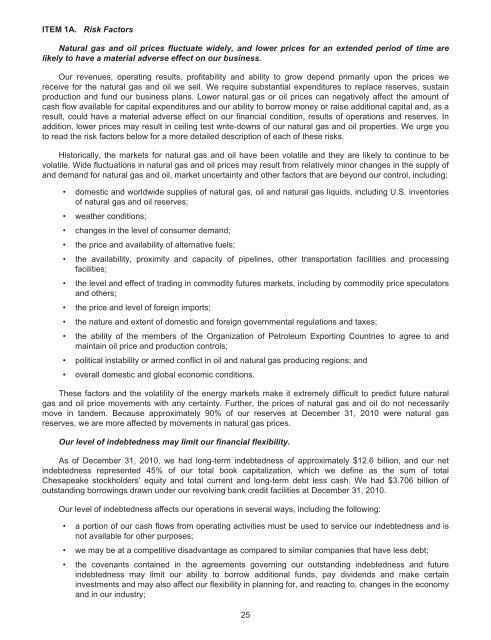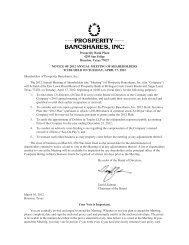6 5 - RR DONNELLEY FINANCIAL - External Home Login
6 5 - RR DONNELLEY FINANCIAL - External Home Login
6 5 - RR DONNELLEY FINANCIAL - External Home Login
Create successful ePaper yourself
Turn your PDF publications into a flip-book with our unique Google optimized e-Paper software.
ITEM 1A. Risk Factors<br />
Natural gas and oil prices fluctuate widely, and lower prices for an extended period of time are<br />
likely to have a material adverse effect on our business.<br />
Our revenues, operating results, profitability and ability to grow depend primarily upon the prices we<br />
receive for the natural gas and oil we sell. We require substantial expenditures to replace reserves, sustain<br />
production and fund our business plans. Lower natural gas or oil prices can negatively affect the amount of<br />
cash flow available for capital expenditures and our ability to borrow money or raise additional capital and, as a<br />
result, could have a material adverse effect on our financial condition, results of operations and reserves. In<br />
addition, lower prices may result in ceiling test write-downs of our natural gas and oil properties. We urge you<br />
to read the risk factors below for a more detailed description of each of these risks.<br />
Historically, the markets for natural gas and oil have been volatile and they are likely to continue to be<br />
volatile. Wide fluctuations in natural gas and oil prices may result from relatively minor changes in the supply of<br />
and demand for natural gas and oil, market uncertainty and other factors that are beyond our control, including:<br />
domestic and worldwide supplies of natural gas, oil and natural gas liquids, including U.S. inventories<br />
of natural gas and oil reserves;<br />
weather conditions;<br />
changes in the level of consumer demand;<br />
the price and availability of alternative fuels;<br />
the availability, proximity and capacity of pipelines, other transportation facilities and processing<br />
facilities;<br />
the level and effect of trading in commodity futures markets, including by commodity price speculators<br />
and others;<br />
the price and level of foreign imports;<br />
the nature and extent of domestic and foreign governmental regulations and taxes;<br />
the ability of the members of the Organization of Petroleum Exporting Countries to agree to and<br />
maintain oil price and production controls;<br />
political instability or armed conflict in oil and natural gas producing regions; and<br />
overall domestic and global economic conditions.<br />
These factors and the volatility of the energy markets make it extremely difficult to predict future natural<br />
gas and oil price movements with any certainty. Further, the prices of natural gas and oil do not necessarily<br />
move in tandem. Because approximately 90% of our reserves at December 31, 2010 were natural gas<br />
reserves, we are more affected by movements in natural gas prices.<br />
Our level of indebtedness may limit our financial flexibility.<br />
As of December 31, 2010, we had long-term indebtedness of approximately $12.6 billion, and our net<br />
indebtedness represented 45% of our total book capitalization, which we define as the sum of total<br />
Chesapeake stockholders’ equity and total current and long-term debt less cash. We had $3.706 billion of<br />
outstanding borrowings drawn under our revolving bank credit facilities at December 31, 2010.<br />
Our level of indebtedness affects our operations in several ways, including the following:<br />
a portion of our cash flows from operating activities must be used to service our indebtedness and is<br />
not available for other purposes;<br />
we may be at a competitive disadvantage as compared to similar companies that have less debt;<br />
the covenants contained in the agreements governing our outstanding indebtedness and future<br />
indebtedness may limit our ability to borrow additional funds, pay dividends and make certain<br />
investments and may also affect our flexibility in planning for, and reacting to, changes in the economy<br />
and in our industry;<br />
25











